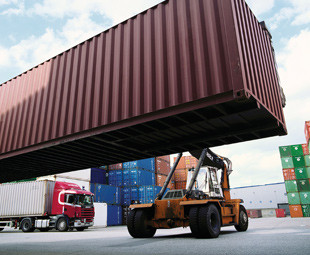Are those skid marks?

Skid marks… telltale signs that something went badly wrong. STUART MOIR explores the role of tyre manufacturers, service providers and fleet managers in ensuring that tyres are correctly maintained.
As tyre manufacturers keep reminding us, these bits of black rubber play a crucial role in a vehicle’s performance – which is why their maintenance is so vitally important. But as Goodyear national fleet manager, commercial sales, André Human, points out: “Drivers and even technical staff members sometimes give more lip service than substance to their tyre inspections. The temptation is to walk past trucks and trailers, instead of doing a proper inspection.” This could be why one of the most costly overhead expenses for transport operators is the cost of replacing tyres.
Correct tyre maintenance is best achieved by way of a partnership between tyre manufacturers, service providers and fleet owners. Nevertheless, as general sales manager commercial vehicle tyres at Continental Tyre SA, Brian Clarke, maintains: “Drivers cannot be discounted as key participants in tyre management programmes. Unfortunately, over the past decade drivers have played a diminishing role in managing their trucks’ tyres. However, experience has shown that fleets in which tyre management forms part of a driver’s responsibilities have significantly lowered tyre costs.” That said, the overall responsibility for tyre management ultimately rests with vehicle owners – who, because of economic constraints, often find themselves investing in cheaper Asian imports.
Many factors affect cost, but some operators focus on meeting short-term requirements rather than the long-term benefits of investing in a well-known, quality tyre. “Often, they are left handling their own maintenance on a cheaper imported tyre,” Clarke continues. “Top-end tyre service providers, on the other hand, strive to assist fleet operators with any maintenance enquiry or shortcoming. Excellent after-sales service is definitely a must-have.”
IN NEED OF SERVICING
Inadequate tyre maintenance inevitably leads to a range of operational difficulties, the most obvious of which are roadside breakdowns, increased down time and higher than necessary expenditure on new tyres. But according to Alexandre Hennion, marketing manager, Michelin Tyre Company South Africa, this is just the tip of the iceberg. “Pressure, re-grooving and alignment have a direct impact on a truck’s rolling resistance, so inadequate tyre maintenance can have serious consequences for fuel consumption,” he maintains.
Trentyre national commercial fleet manager, Peter van Rooyen, says that pre- and post-trip tyre inspections, combined with the necessary corrective maintenance before getting underway, are the first lines of defence against tyre problems. “Tyres account for a substantial percentage of long-haul fleet maintenance expenses, and an even greater proportion for fleets that run off road. It is crucial that these tyres are maintained to the highest possible standard to avoid a spiralling operating cost per kilometre (cpk). Running a tyre under-inflated increases its rolling resistance, causes excessive wear and tear, and increases fuel consumption – all preventable expenses,” he points out.
Bridgestone South Africa’s public relations manager, Mandy Lovell, believes that road conditions are arguably the worst they have been in 30 years. Figures released by Government confirm this trend; it is a well-known fact that South Africa’s roads are rapidly disintegrating. Because of this, tyres are being damaged on an alarming scale. “The importance of correct tyre maintenance and strict tyre management has seldom, if ever, been such a high priority. Drivers should be trained to identify problems by checking air inflation pressures and tread depth. They should know when a tyre is due for repair or replacement,” she urges.
Transport operators cannot afford to have vehicles standing because of inadequately maintained tyres, so tyre manufacturers are becoming increasingly involved in on-site tyre management via their service provider partners. Notes Van Rooyen: “As transport has evolved and become more demanding, complicated and time-oriented, so the tyre manufacturers, suppliers and service providers have had to move with those changes in the market. We have had to become far more integrated into an end-user’s business.”
BETWEEN THE LINES
Of course, while transport operators contract out some functions, proper tyre maintenance is a team effort. “There has to be synergy and understanding between the customer and the service provider,” says Lovell. “Fleet managers must co-ordinate operations in such a way that vehicles are available for inspection at regular intervals. They must also ensure that sufficient budget is available to address problems as and when they arise.”
 According to Tony Burns, Max T Solutions’ general manager, marketing, “Tyre manufacturers’ initial involvement with an end-user’s fleet is normally around tyre pressure and application recommendations, as well as ongoing scrap tyre analysis and test tyre programmes. On the whole, manufacturers do not get overly involved with an end-user’s fleets as such; on- and off-site service requirements are normally a function that tyre retailers perform. Invariably, however, each tyre manufacturer has some sort of affiliation with a service provider.”
According to Tony Burns, Max T Solutions’ general manager, marketing, “Tyre manufacturers’ initial involvement with an end-user’s fleet is normally around tyre pressure and application recommendations, as well as ongoing scrap tyre analysis and test tyre programmes. On the whole, manufacturers do not get overly involved with an end-user’s fleets as such; on- and off-site service requirements are normally a function that tyre retailers perform. Invariably, however, each tyre manufacturer has some sort of affiliation with a service provider.”
In Burns’ view, because the consequences of incorrect tyre maintenance can be costly and even fatal, it is vital to study data pertaining to tyre wear on specific vehicles. Bandag marketing director, Laurent Colrat, agrees. “In an effort to manage tyre and tyre-related costs, tyre service providers must not only gather data; they must use it to introduce tyre-saving policies that monitor performance, implement corrective action and ultimately improve cpk,” he explains.
It is this data that informs whether or not retreading a tyre is viable. As Human notes, “While improved casing retread technology means disposing of fewer casings – with obvious environmental benefits – data gathered by large retreading groups who track the retreadability of tyres by brand has pointed to some interesting trends.” Michelin’s Hennion elaborates: “The premium brands often show improved retreadabilty results over non-premium brands, and in many instances the quality of a premium brand’s casing will allow for an additional retread.”
ENTER THE ASIANS
However, the competitive price of Chinese, Korean and Indian tyres could mean it’s cheaper to replace tyres than retread – and those Eastern imports aren’t all bad. Industry experts tell FOCUS that, despite widespread misconceptions about imported Asian tyres in general, some have definite merits. As a result, their market share is growing locally all the time – some say it’s as high as 25%. According to the authoritative Southern Africa Treads magazine, well over 40 different brands are currently coming to South Africa from China alone.
So… how have Chinese tyre manufacturers accomplished this? Clarke believes the answer is what is called a “knock-and-drop” business model, whereby they flood the market with reverse-engineered products. Of course, this exercise isn’t always successful, largely because the companies concerned are unaware of the rubber compounds used. Having said this, the Chinese companies persist. “We invest in manufacturing better tyres through in-depth research; then Asian manufacturers attend tyre expo events, photograph the tyre and try to imitate it,” Clarke maintains.
This policy appears to have met with success. According to David Wilson, publisher of the UK’s Retreading Business magazine, China is now the biggest producer of truck tyres worldwide. Speaking at Tyrexpo in Johannesburg earlier this year, Wilson pointed out that the nine biggest Chinese companies are now producing over two million tyres annually. “Some of the Chinese companies are major players, with significant technical capability based on Western technology,” he noted.
The challenge for operators, of course, is differentiating between those major players – with good products – and those companies that are producing sub-standard tyres.
While the quality of the Chinese imports may or may not be up to scratch, concerns have also been expressed over operators using the wrong tyre for specific applications. “Some Chinese tyres are appropriate for some local conditions but they’re mass-produced to one specification. Local tyre manufacturers produce tyres to handle our road conditions and to specific applications, which offer long-term benefits for transport operators,” says Clarke. “It’s important to properly evaluate tyres before using them wholesale across the fleet. This most certainly applies to the Asian imports.”
But some transport operators don’t do this. They buy only on price – and if those Asian imports offer the best financial deal, they will grab them with both hands. This may impact on that operator’s profitability and it can also impact on the local tyre industry, which continues to reel from Government’s refusal to implement tougher anti-dumping duties against Eastern importers.
Ultimately, the message is clear: transport operators need to be vigilant in selecting their tyres in the first place. And then they need to care for them properly, or face expensive consequences.
Published by
Focus on Transport
focusmagsa



